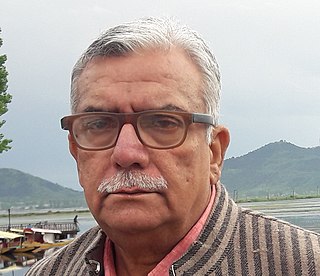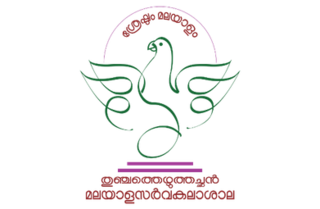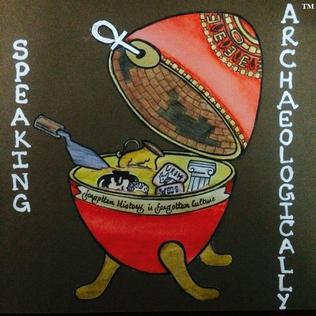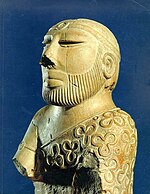
Museology or museum studies is the study of museums. It explores the history of museums and their role in society, as well as the activities they engage in, including curating, preservation, public programming, and education.

Cultural heritage is the heritage of tangible and intangible heritage assets of a group or society that is inherited from past generations. Not all heritages of past generations are "heritage"; rather, heritage is a product of selection by society.

Indira Gandhi National Centre for the Arts (IGNCA), New Delhi is a premier government-funded arts organization in India. It is an autonomous institute under the Union Ministry of Culture.

The National Museum in New Delhi, also known as the National Museum of India, is one of the largest museums in India. Established in 1949, it holds a variety of articles ranging from pre-historic era to modern works of art. It functions under the Ministry of Culture, Government of India. The museum is situated on Janpath. The blue–print of the National Museum had been prepared by the Gwyer Committee set up by the Government of India in 1946. The museum has around 200,000 works of art, mostly Indian, but some of foreign origin, covering over 5,000 years.

The Ministry of Culture is the Indian government ministry charged with preservation and promotion of art and culture of India.
Haku Vajubhai Shah was an Indian painter, Gandhian, cultural anthropologist and author on folk and tribal art and culture. His art belonged to the Baroda Group and his works are considered in the line of artists who brought themes of folk or tribal art to Indian art.

Dr. Lalit Gupta , is an Indian art historian, columnist, actor and film maker. He is an authority on Art History, remained head of Art History and Aesthetics wing in State Institute of Music and Fine Arts located in Jammu for three decades. He has remained associated with the prestigious projects that document the heritage, paintings and sculptures of Jammu and Kashmir, and he has created a rare archive of photos and slides of important monuments and art works from all three regions of the erstwhile state viz., Ladakh, Kashmir and Jammu.

Thunchath Ezhuthachan Malayalam University, also called Malayalam University, is a state university in Tirur, Kerala, India.
Rummana Hussain (1952–1999) was an artist and one of the pioneers of conceptual art, installation, and politically engaged art in India.
Ravindra Singh Bisht is an Indian archaeologist, known for his scholarship on Indus valley civilization and efforts to conserve Indian national monuments. He was honoured by the Government of India, in 2013, by bestowing on him the Padma Shri, the fourth highest civilian award, for his contributions to the field of archaeology.

Alka Pande is an Indian academic, author and museum curator.

Aditya Pande is an Indian contemporary artist. His technique often involves a layering of surfaces along with mixed, diverse media ranging from vector drawing, digital photography, ink, acrylic paint to tinsel. His work combines the skills of drawing and printmaking with photography and painting.
Shobha Deepak Singh is an Indian cultural impresario, photographer, writer, classical dancer and the director of Shriram Bharatiya Kala Kendra, a Delhi-based cultural organization which promotes music and performing arts, through its schools and stage shows. She is known for her contributions for the revival of Mayurbhanj Chhau, a tribal martial dance form from Odisha. The Government of India awarded her the fourth highest civilian award of the Padma Shri in 1999, for her contributions to Arts and culture.
Lalit Pande is an Indian social worker, environmentalist and the founder of Uttarakhand Seva Nidhi Environmental Education Centre, a non governmental organization promoting environmental education in the hilly areas of the Indian state of Uttarakhand. Under the aegis of the organization, Pande is known to have introduced community educational programmes focused on environment and development and supported over 200 community based organizations in the state. The Government of India awarded him the fourth highest civilian honour of the Padma Shri, in 2007, for his contributions to environmental education.

Bulu Imam is an environmental activist working for the protection of tribal culture and heritage in Jharkhand. On 12 June 2012, he received the Gandhi International Peace Award, 2011 at the House of Lords in London. He is also a recipient of the Padma Shri (2019). He is the grandson of Syed Hasan Imam, who was a leading Barrister and Judge of Calcutta High Court (1912–1916), and the President of the Indian National Congress.
Amir Hossein Zekrgoo is an Iranian artist, art historian and Indologist. He has been professor of Islamic and Oriental arts at the International Institute of Islamic Thought and Civilization (ISTAC) from 2001 to 2016. He was awarded Ikuo Hirayama Silk Roads Fellowship by UNESCO.

Speaking Archaeologically is an archaeological education group, based in India. Founded by Shriya Gautam—alongside colleagues Lyn Pease, Catherine Holtham-Oakley, Max Zeronian-Dalley and Molly Lockeyear–in June 2015, it focuses on the documentation of neglected and forgotten archaeological sites, object analysis, and rescue archaeology.

Diwan Manna is an Indian conceptual artist and photographer. He completed his study in graphic art and printmaking from the Government College of Art, Chandigarh in 1982. He exhibited in India, United Kingdom, Germany, France, Poland, and Italy. From 2014 to 2015 he served as the director of Triennale India, organised by Lalit Kala Akademi, National Academy of Art, Ministry of Culture, Govt of India. He served as the chairman of Chandigarh Lalit Kala Akademi, State Academy of Art, Department of Culture, Chandigarh Administration. Currently, he is serving as the president of Punjab Lalit Kala Akademi, State Academy of Art, Ministry of Culture, Government of Punjab, India.
Pushkar Sohoni is an architect, an architectural and cultural historian. He is an Associate Professor and the Chair of the department of Humanities and Social Sciences at the Indian Institute of Science Education and Research, Pune.
Vasudeva Sharan Agrawala, also Vasudeva Saran Agrawala, (1904–1966), was an Indian scholar of cultural history, Sanskrit and Hindi literature, numismatics, museology, and art history. He received the Sahitya Akademi Award in the Hindi language in 1956 for his prose commentary Padmavat Sanjivani Vyakhya. He was a professor in the Department of Art and Architecture at the Benares Hindu University.






















